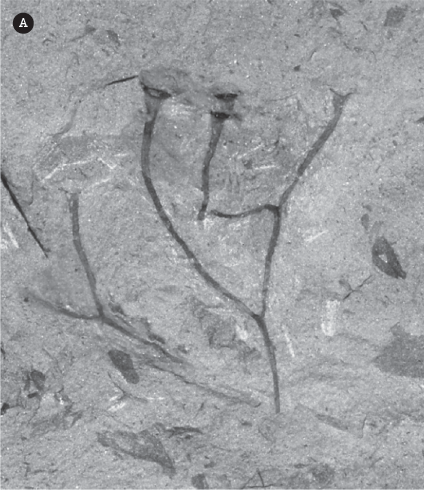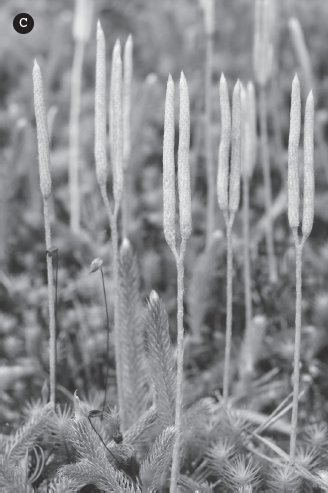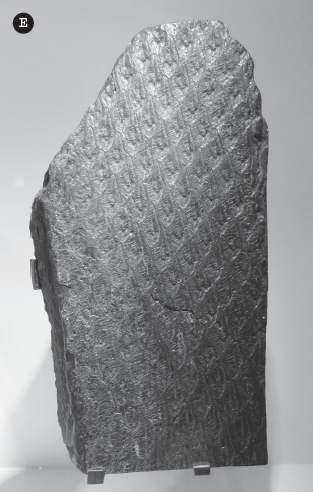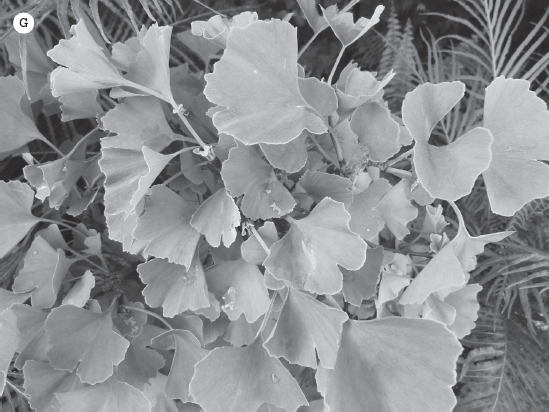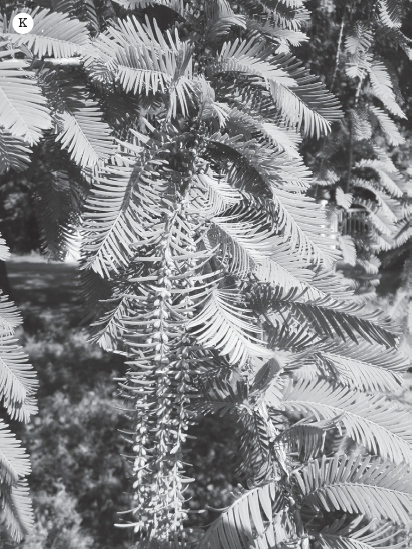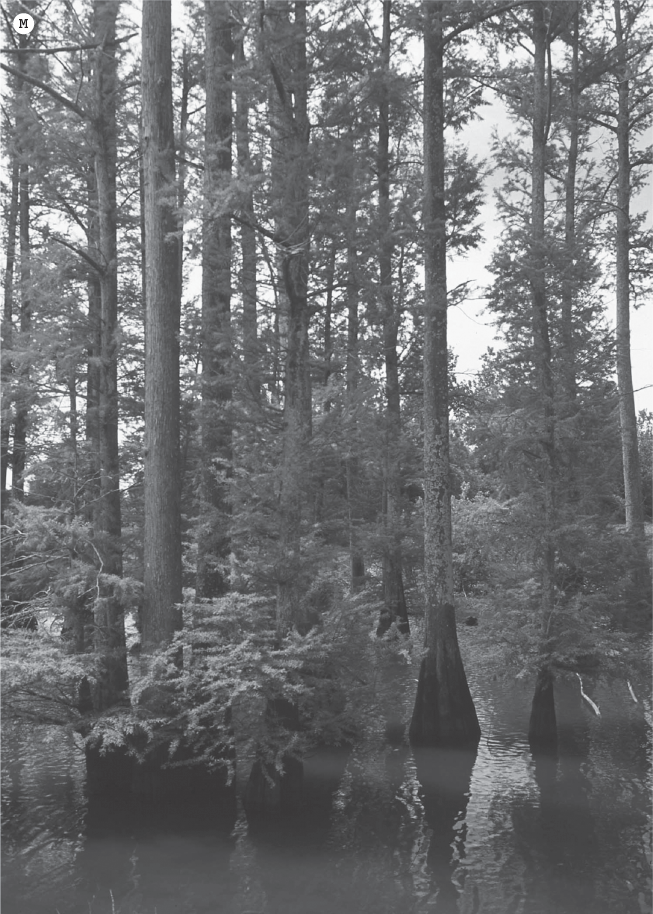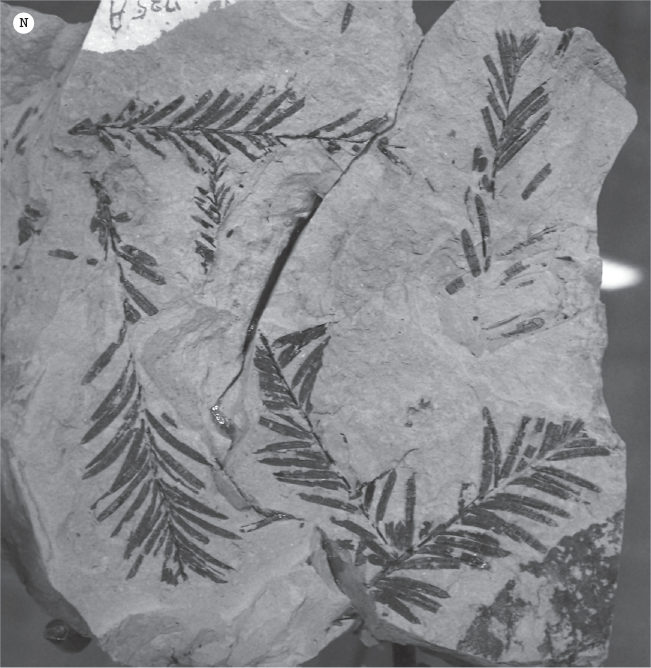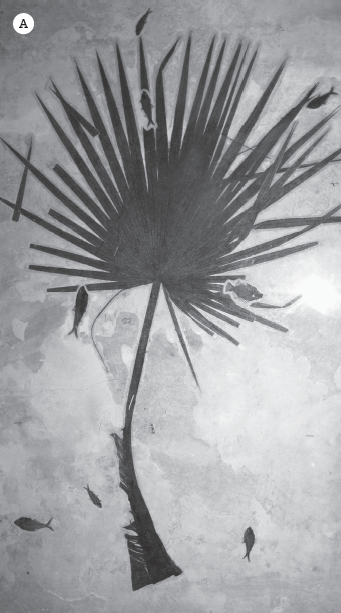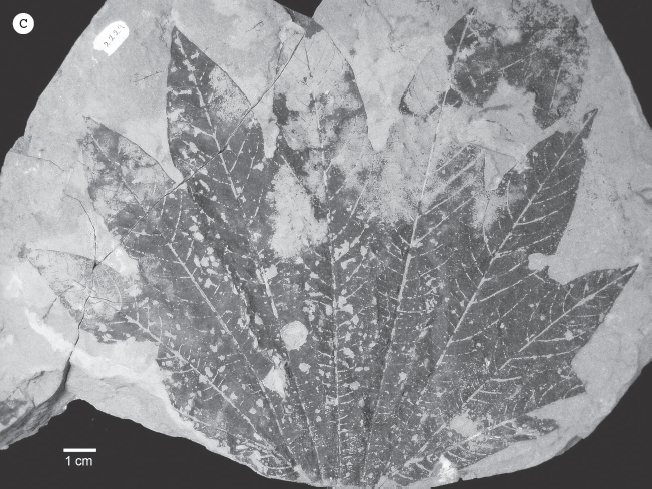Animal fossils are far more popular, but there are many places in the United States where abundant plant fossils can easily be collected as well. Like many types of animal fossils, only parts of the whole organism are found for most plant fossils: leaves, stems, trunks, roots, seeds, and so on. In many cases, paleobotanists (paleontologists who specialize in plant fossils) cannot conclusively show which leaf fossil belongs with which kind of petrified wood, but in rare cases, the entire plant from roots to leaves is preserved (fig. 20.1). In some places, especially ancient coal swamps and at the bottom of stagnant lakes, we find preserved plants in abundance. Other places, such as the Big Badlands of South Dakota, have preserved an amazing array of fossil animals—from tortoises and snails to many different kinds of mammals—but little evidence of the fossil plants that must have fed these creatures is found beyond the root casts and seeds of the hackberry bush (Celtis), which are calcified and were practically stone while the plant was alive.
Figure 20.1 ▲
Evolution of land plants, showing the early diversification of spore-bearing plants, including horsetails (sphenophytes), ferns, and club mosses (lycopods). The first seed-bearing plants were gymnosperms, including seed ferns, cycads, and conifers. In the Early Cretaceous, there was a huge radiation of flowering plants, and they dominate most of the land plant diversity today. (Illustration by Mary Persis Williams)
In some cases, the preservation is extraordinary. The famous Miocene Clarkia beds of western Idaho are so poor in oxygen that when you split open a shale slab the 15-million-year-old leaves are still green. As they react to the oxygen in the air, they turn brown and can blow away in a matter of minutes if not quickly sealed in a preservative.
These early plants are important because they are the base of the food chain for almost all life, and they provide our only source of oxygen. Plant life made Earth habitable for other life forms, something that probably has not happened on any other planet. The earliest photosynthetic bacteria spent almost 1.5 billion years pumping out oxygen after they first evolved about 3.8 billion years ago. It was not until about 2.4 to 1.8 billion years ago that enough oxygen had accumulated for the atmosphere to change from oxygen-starved to oxygen rich enough for animals to evolve. Without plants, Earth would have been as lifeless as Mars, which has no great biomass of plants to make oxygen and allow animals to grow. Likewise, those who imagine intelligent life on other planets forget how our planet only has life because of its perfect position between frozen Mars and scorching Venus, so it is not too hot and not too cold. Just finding a planet with the right temperature is not enough. It must have oceans of liquid water and some kind of organism that can produce oxygen before life like that found on Earth could arise.
For nearly all of life’s history on Earth, until about 400 million years ago, the surface of the land was completely barren, exposed to the forces of weathering and erosion with no plants on the surface other than lichen-like organisms. Once large plants with tree-like shapes evolved in the Devonian, they transformed the land, making it habitable for the first animals to crawl out of the water. The millipedes were the first to do this, followed by scorpions, spiders, insects, and eventually the first amphibians.
Once forests with lots of woody biomass evolved in the Carboniferous Period, the atmosphere was transformed. Plants pumped out so much oxygen that gigantic insects and millipedes could evolve. The plants absorbed carbon dioxide, locking it into the earth’s crust as coal. Apparently, there were no termites or other wood-digesting insects yet, so huge volumes of plant matter went directly to coal without the usual decomposers that break up decaying plant matter. Eventually, plants pulled so much carbon out of the atmosphere that the world was pushed into a glacial state in the Early Permian, about 300 million years ago. Not only are fossil plants the source of coal, but most of the world’s oil was produced by the bodies of ancient planktonic algae that died and was locked into the rocks. Without plants, there would be no stored energy in the form of fossil fuels on which our society depends.
Over the course of the past 400 million years, plants have been Earth’s great thermostat, growing and flourishing to pull excess carbon out of the atmosphere in a greenhouse world and releasing carbon through decay and burning to keep the planet from freezing over completely. The great stores of carbon locked up in the earth’s crust as coal (and also as limestone, produced by marine plants and animals) is the switch on that thermostat. Sadly, we are now burning huge amounts of the coal that was stored in the crust for at least 300 million years, and this is pushing the planet back into a greenhouse world, upsetting the natural balance that had been stable for millions of years.
MICROBIAL FOSSILS
The simplest fossils of photosynthetic organisms are produced by sticky mats of microbes, especially blue-green bacteria (cyanobacteria), and by simple algae. Most of their fossils are extremely tiny and can only be seen under a microscope. The only visible fossils they leave are layered structures known as stromatolites (fig. 20.2A–B). They look a bit like cabbages when sliced open, with fine millimeter-scale layers in flat mats, or in domes or even pillars. They are the oldest megascopic fossils on the planet, dating back at least 3.5 billion years, and from then until about 700 million years ago (for almost 3 billion years), they were the only visible life on Earth.
Figure 20.2 ▲
Stromatolites are layered, cabbage-shaped structures formed by sediment trapped by layers of sticky cyanobacterial mats. (A) The finely laminated structure of a stromatolite is diagnostic. (B) For most of the history of life on Earth, the shallow nearshore waters hosted the only life, mounds and domes of sticky cyanobacterial mats that formed stromatolites. (Illustrations by Mary Persis Williams)
Stromatolites form from sticky mats of bacteria or algae that grow where the light penetrates the sea surface, usually in lagoons and shallow seafloors in the intertidal zone. When the tide is high and they are immersed in water, tiny filaments of bacteria or algae grow up through the sediment washed on top of the older part of the sticky mat, making a new sticky mat on top of the old sediment. Some stromatolites can trap a new layer of sediment every day, although usually they do not grow this fast for very long. Stromatolites are important indicators of ancient environments and are the earliest megascopic record of life.
ALGAL FOSSILS
Algae are the earliest form of plants; they are simple structures that have no hard woody tissues to raise them out of the water. Algae tend to be mostly tiny microscopic cells, but some can make huge structures, such as the submarine forests made of the fronds of kelp. They do not have many of the specialized features found in more advanced plants, so they must always live in water, or near water in a moist habitat.
Most algae do not have hard mineralized tissues, so they do not fossilize. However, some planktonic algae, like diatoms and coccolithophorids, do leave their tiny shells behind. Diatoms may bloom and reproduce and then die in the trillions to make a rock called diatomaceous earth, or diatomite, which is a densely packed mix of pure diatoms. It is mined for water filters, kitty litter, and many other purposes. Coccolithophorid algae bloomed in huge numbers in shallow oceans (especially during the Cretaceous Period) to produce large volumes of limestone made up of their shells, which we know as chalk. The famous White Cliffs of Dover are made of Cretaceous chalk, and there are important chalk beds from the Cretaceous of Belgium and France as well as in the United States in Alabama and Texas and western Kansas.
The most commonly collected megascopic algal fossils are structures known as a receptaculitids, nicknamed “sunflower corals” (fig. 20.3A–B). For many years, paleontologists puzzled over these strange structures, which look vaguely like a coral head, with a distinctive spiral pattern of cells on top that reminds one of a sunflower head. In older fossil guidebooks, these fossils were often placed with the corals or with the sponges or indicated as a mystery. Recent research, however, has shown that they are the product of a group of living plants known as the dasycladacean algae. Receptaculitids were particularly important as reef builders during the Ordovician, and they are often collected as large complete specimens in Ordovician beds all over the Midwest, from the Cincinnati Arch to Indiana, Tennessee, Wisconsin, and Iowa.
Figure 20.3 ▲
The receptaculitids, or “sunflower corals,” are not corals at all but a structure built by a dasycladacean alga. (A) Reconstruction of the structure of a complete specimen, showing the spiral patterns on the surfaces. (B) A typical specimen, showing the sunflower-like pattern on the surface. ([A] Illustration by Mary Persis Williams; [B] courtesy of Wikimedia Commons)
VASCULAR PLANTS: FERNS, CLUB MOSSES, AND HORSETAILS
Algae must live and reproduce entirely in water, and they have no structures that allow them to stick up above the land surface. Neither do mosses, which are among the most primitive of land plants. Mosses cannot grow tall and must also remain moist at all times. A great breakthrough occurred when plants evolved a vascular system of tubes running up long stems to bring water and nutrients from the roots, transport the material produced by photosynthesis up in the leaves, and then move it back through the rest of the plant. Eventually, they evolved stiff woody tissues made of the protein lignin, which makes them rigid enough to stand taller and taller. These plants are known as vascular plants, and they are the first plants to grow fully on land and to be able to stand tall above the surface. (Refer to figure 20.1 to review the evolution of land plants.)
The first vascular plants, or tracheophytes, are simple fossils such as Rhynia or Cooksonia, from the Late Silurian and Early Devonian (fig. 20.4A–B). They are not much more than a short vertical stem a few centimeters tall, topped by a reproductive structure at the top, with only minimal branching. They had no leaves, so they must have conducted photosynthesis through the surface of their stems.
Figure 20.4 ▲
The earliest vascular plants. (A) Specimen of Cooksonia and (B) a reconstruction of the fossil, showing the long stems without leaves topped by the spore-bearing sporangia. (C) The living club moss, Lycopodium and (D) a reconstructions of the giant lycophyte tree Lepidodendron, which reached heights of more than 120 feet (36.6 meters). (E) Typical lycophyte trunk, showing the diamond-shaped leaf scars on the bark, and (F) reconstruction of another common lycophyte, Sigillaria, showing the vertical scars up the trunk. (G) The living horsetail or scouring rush Equisetum, and (H) Annularia, a fossil horsetail from the Carboniferous. (I) Reconstruction of the tall Carboniferous sphenophyte tree Calamites. ([A] Courtesy of Hans Steuer; [B] courtesy of N. Tamura; [C, E, G–H] courtesy of Wikimedia Commons; [D, F, I] illustrations by Mary Persis Williams)
One of the first successful groups of vascular plants is the lycophytes, represented today by about a thousand species of club mosses and quillworts. They are moisture-loving, low-growing, ground plants and are quite common in certain places, although most nonbotanists do not notice them. One genus, Lycopodium, or the “ground pine,” is a typical creeping plant in the undergrowth of northern forests (fig. 20.4C). These low-growing evergreen plants grow in long strands like ivy and are popular for making Christmas wreaths and garlands. They are more advanced than Rhynia and the primitive vascular plants because they are the first plants to have leaves and roots.
Fossil lycophytes first appeared in the Late Silurian and Devonian and were the first vascular plants to rise more than a few feet above the land surface. By the Carboniferous, they grew to be the first large trees on Earth; some were more than 120 feet (36.6 meters) tall with trunks more than 6 feet (2 meters) in diameter (fig. 20.4D–E). They were the dominant plants in the great coal swamps of the Carboniferous Period, and their fossils are easy to collect and recognize in old spoil piles from coal mines. One of the best known is Lepidodendron, the “scale tree,” which had distinctive diamond-shaped scars on the bark of the trunk from old leaves that had fallen off (fig. 20.4D–E). Its leaves were short and blade-like and attached directly to the trunk in a spiral pattern. Sigillaria was a slightly shorter lycophyte, with clusters of leaves arranged at the ends of its branches and leaf scars that appear to be arranged in vertical lines up the trunk (fig. 20.4F). After dominating the swampy regions of the Paleozoic, lycophytes declined in the Mesozoic and were replaced by more advanced trees. Most were only shrub-sized or smaller and were found in Mesozoic wetlands. Only the smaller herbs such as Lycopodium survive today.
Slightly more advanced are ferns, which have a rigid stem and many leaves that branch in pairs from the stem. Ferns first appeared in the Carboniferous Period, and they quickly radiated into a huge diversity of different forms. More than 12,000 species are alive today. Like other primitive vascular plants, they do not have seeds but spores that require moist conditions to germinate and grow, so ferns are usually found in damp conditions in or near water. Ferns are often fossilized in swampy deposits around coal seams, and fern fossils are common and easy to collect if you are in the right place. Most ferns today are quite small, although tree ferns still grow in the damper forests of the world. During the Carboniferous, the huge fern Psaronius reached 33 feet (10 meters) in height.
A third important group of early vascular plants are the sphenophytes, known from the modern “horsetail” or “scouring rush” (genus Equisetum). There are only about 20 living species, and most are found in swampy wetlands today (fig. 20.4G–H). The pioneers called them “scouring rushes” because their stems are full of silica abrasive, and they could be wadded up to make a scouring pad for washing dishes in pioneer days. Sphenophytes have long straight hollow stems separated into segments by joints, and their leaves radiate out from the joints. Most living species are short (barely 3 feet tall or less), but in the Carboniferous coal swamps there were huge trees called Calamites, which were 66 feet (20 meters) tall (fig. 20.4I).
GYMNOSPERMS: CONIFERS AND THEIR RELATIVES
All these primitive vascular plants (lycophytes, ferns, sphenophytes) reproduced with spores and required moist conditions and a film of water for the sperm to reach the egg. They were successful in the moist, swampy conditions of the Carboniferous, but they could not survive far from large bodies of water. During the Late Devonian, plants began to evolve a key adaptation that enabled them to breed in drier conditions: the seed. The first seed plants were the progymnosperms, which had a simple naked seed that did not require water for fertilization. They also had true woody tissue in their trunks. In the Late Devonian in places like the Gilboa Forest in the Catskill Mountains of New York, the trunks of huge progymnosperm trees like Archaeopteris were over 40 feet (12 meters) tall (fig. 20.5A).
Figure 20.5 ▲
Fossil gymnosperms had primitive seeds, which allowed them to reproduce on dry land. (A) Reconstruction of the progymnosperm Archaeopteris, showing the details of the trunk, leaves, and roots. (B) The fossil seed fern Neuropteris from the Carboniferous, and (C) the tongue-shaped fossil leaves of Glossopteris, a common Permian seed fern on all the Gondwana continents. (D) Typical log from the Petrified Forest of Arizona, showing the original tree rings of this relative of the modern Araucaria. (E) Living Araucaria, also known as the Norfolk Island pine, and (F) close-up of the distinctive needles of Araucaria. (G) The distinctive duck-foot-shaped leaves of the maidenhair tree, Ginkgo biloba. (H) Two modern cycads, with a large round female cone on the left and a tall narrow male cone on the right, and (I) the fossilized trunk of a cycad from the Jurassic of South Dakota. (J) The archaic conifer Metasequoia, known as the “Dawn Redwood”; (K) close-up of the seeds of Metasequoia; and (L) cone of Metasequoia from the late Eocene Badger’s Nose flora, Warner Range, northeastern California. (M) The modern bald cypress Taxodium, and (N) fossil Taxodium branches. ([A] Courtesy of G. Retallack; [B–C, G, I–K, M–N] courtesy of Wikimedia Commons; [D–F, H] photographs by the author; [L] courtesy of J. Myers)
Another group of late Paleozoic plants had even more advanced seeds. They are mislabeled the seed ferns, but they are not related to true ferns because they have seeds instead of spores (fig. 20.5B). They were particularly common in the Carboniferous and Permian, especially in drier uplands habitats that were too arid for swamp plants like lycophytes, sphenophytes, or true ferns. The most famous of the seed ferns was a fossil known as Glossopteris (“tongue leaf” in Greek), which was found on all the Gondwana continents during the Permian (fig. 20.5C). It was one of the earliest fossils to suggest continental drift. Both of these early seed plants are now extinct.
By the Late Permian and especially in the early Mesozoic, a new group called gymnosperms (“naked seeds” in Greek) had appeared (see fig. 20.1). They almost all have their seeds within cones, so many of them are called “conifers.” In most cases, distinct male and female cones have different reproductive features. When the male cone releases pollen into the air, the female cones open, and their sticky sap traps the airborne pollen, bringing it to the egg where it is fertilized.
There are more than 650 living species of gymnosperms, including pines, firs, spruce, and hemlock. The largest living organisms on Earth, the giant sequoia trees (which can be 340 feet [110 meters] tall and weigh many tons), and the oldest living organisms on Earth, the bristlecone pines (which can survive up to 10,000 years), are also gymnosperms. Conifers are very hardy, successful trees whose narrow needles enable them to conserve water and survive in cold conditions where other plants cannot live. They first appeared in the Late Carboniferous, and in the Permian large conifers like Cordaites were over 80 feet (25 meters) tall with leaves more than three feet (1 meter) long. Conifers took over nearly all the drier upland habitats in the Triassic and Jurassic. The famous fossil wood of the Petrified Forest National Park in Arizona (fig. 20.5D) comes from the same family as the living Araucaria (the Norfolk Island pine), which is now a common tree in cultivated areas, although originally it was found only in and around southern New Zealand and South America (fig. 20.5E–F). Fossil pines were abundant in the Jurassic beds of North America and were often fossilized in Cenozoic plant localities as well.
In addition to Araucaria and pine trees, there are a number of other types of gymnosperms. The most familiar is the ginkgo tree, or “maidenhair tree,” Ginkgo biloba, with its distinctive “duck’s foot” shaped leaves (fig. 20.5G). Today it is found in cities and gardens all over the world, and it is also popular as an herbal medicine. Until 1690, when botanists discovered it on the grounds of a Chinese temple and spread it around the world, it lived only in a few remote areas of eastern Asia. Although is it a gymnosperm with simple small cones, it has broad leaves rather than needles. In addition, it is deciduous not evergreen; the leaves turn yellow and are shed abruptly in a few days in the fall, and they grow back in the spring. Many people see ginkgo trees in the cities and in their gardens and do not realize it is a living fossil more closely related to a pine tree than to any other tree.
The other important group of Mesozoic gymnosperms is the cycads. These are common in gardens today, where they are sometimes called “sago palms,” but they are gymnosperms, not palm trees. Each cycad plant is either male or female and generates a male or female cone when they breed (fig. 20.5H). Cycads have a stumpy trunk with scars of old branches that resemble a pineapple and large palm-like fronds that are very stiff and fibrous. Today they are found mainly in the tropics and subtropics, and they are common in gardens in frost-free parts of the world. But during the Jurassic, they were one of the most common plants of all (fig. 20.5I), and their distinctive stumps (along with a similar-looking plants called cycadeoids) are often found in the dinosaur-bearing formations of the Rocky Mountains, such as the Upper Jurassic Morrison Formation and the Lower Cretaceous Dakota Group.
One of the most common fossil gymnosperms from the Mesozoic were the archaic conifers known as the dawn redwood, or Metasequoia (fig. 20.5J–L). Even though it looks superficially like other kinds of conifers, it is very distinctive. It was first known from fossils, but in 1944 it was found alive in the Hubei Province of China, a true living fossil. It has been planted all over the world now, another living fossil (like the ginkgo) that survived in China and then spread to many different regions. Another important Mesozoic conifer is the bald cypress Taxodium, which is frequently found in swamps today (fig. 20.5M–N). It is also common in Cretaceous swamp and floodplain deposits where dinosaur fossils are found.
ANGIOSPERMS: FLOWERING PLANTS
All of the vascular plants I have mentioned are less than 5 percent of the diversity of living land plants. Today only one group dominates: the angiosperms, or flowering plants. With more than 250,000 living species, they are the majority of plants of most land habitats on Earth. Nearly every plant you see (except conifers and ferns), every plant you find in a nursery or garden, and every plant we use for food is an angiosperm. But angiosperms were a comparatively late development in plant evolution. They arose in the mid-Mesozoic, but by the Late Cretaceous, they had pushed the conifers into the background.
Angiosperms had several adaptations that gave them advantages over other plants. The most important adaptation was the invention of the flower—a highly modified reproductive organ with the ovary in the center and the male reproductive parts on the outer area. The flower co-evolved with Cretaceous insects, such as bees and butterflies, and these insects pollinated the plants. When an insect visits a flower for its nectar bait, the flower transfers pollen to the insect; when the insect goes to the next flower, it fertilizes that plant. This is a much more efficient way to reproduce than the wind-pollinated gymnosperms or the water-dependent pollination of ferns, mosses, and algae. The embryo in the flower also has a food supply, which enables the seed to germinate even in unfavorable conditions. Angiosperms are also capable of very rapid reproduction and growth, so they can breed or grow back in a few days to weeks, whereas gymnosperms require months or years to grow back after being damaged. During the Cretaceous, duck-billed dinosaurs developed highly efficient pavement-like teeth for grinding plants, and their dino-damage may have given fast-recovering angiosperms an advantage over the gymnosperms. Finally, angiosperms have mastered the trick of vegetative reproduction; that is, the plant can also reproduce by sprouting from a cutting of the stem, or in some cases, an entirely new plant can grow from just a part of the plant stem or root system.
Angiosperms not only dominate the plant world today but also dominate nearly all the plant fossil record in the Cretaceous and the Cenozoic. Many plant fossil localities in the United States produce excellent fossil leaves or petrified wood, from the coal seams of the Cretaceous and Paleocene of Montana and North Dakota to the legendary Eocene leaf beds of Florissant, Colorado, and the Green River Formation in Wyoming, Utah, and Colorado (fig. 20.6A). Fossil leaves have been found in many other places, including at Eocene and Oligocene plant localities on the Gulf Coast and in Oregon, Washington, and northern California (fig. 20.6B–G). Miocene plant localities are found from the Gulf Coast to the Rocky Mountains to the Pacific Northwest (such as the Ginkgo Petrified Forest State Park in Vantage, Washington, which has petrified wood of 50 species of trees). There are numerous other Pliocene and Pleistocene localities across the United States for collecting fossil leaves or petrified wood. The Calistoga Petrified Forest in Sonoma County, California, has complete logs of giant sequoias that were buried in a volcanic ash eruption 3.4 million years ago. They are the largest known petrified logs in the world.
Figure 20.6 ▲
Some typical fossil angiosperms. (A) A frond of the palm Sabalites, along with fossil herrings called Knightia, from the Eocene Green River lake shales of Utah. It is a relative of the modern palmetto tree, genus Sabal. (B) A tropical chestnut, or Sterculia, leaf from the late Eocene LaPorte flora, northern Sierra Nevada, California; (C) a plane tree leaf of the extinct genus Macginitea, from the LaPorte flora; (D) a leaf of Alnus, the alder tree, from the Badger’s Nose flora, Warner Range, northeastern California; (E) a laurel leaf and some pine litter from the Badger’s Nose flora; (F) a magnolia leaf from the Badger’s Nose flora; and (G) a leaf of “Oregon grape,” or Mahonia, from the Badger’s Nose flora. ([A] Courtesy of Wikimedia Commons; [B–C] courtesy of D. Erwin and the University of California Museum of Paleontology; [D–G] courtesy of J. Myers)





